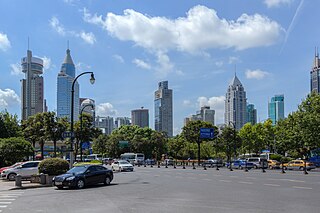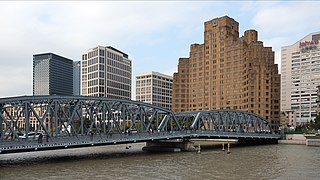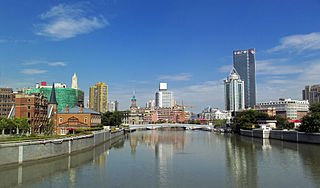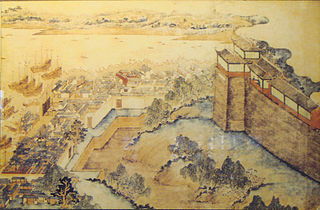
Shanghai is one of the four direct-administered municipalities of China. The city is located on the southern estuary of the Yangtze River, with the Huangpu River flowing through it. The population of the city proper is the third largest in the world, with 24.89 million inhabitants in 2021, while the urban area is the most populous in China, with 39.3 million residents. As of 2018, the Greater Shanghai metropolitan area was estimated to produce a gross metropolitan product (nominal) of nearly 9.1 trillion RMB. Shanghai is one of the world's major centers for finance, business and economics, research, science and technology, manufacturing, transportation, tourism, and culture. The Port of Shanghai is the world's busiest container port.

Huangpu District, makes up the eastern part of Shanghai's traditional urban core and is today the most central of Shanghai's 16 districts. Huangpu district is the seat of municipal government, includes key attractions such as The Bund and the Old City God Temple, as well as popular shopping districts such as Nanjing Road, Huaihai Road, and Xintiandi. The Huangpu District is one of the most densely populated urban districts in the world.

The Bund is a waterfront area and a protected historical district in central Shanghai. The area centers on a section of Zhongshan Road within the former Shanghai International Settlement, which runs along the western bank of the Huangpu River in the eastern part of Huangpu. The area along the river faces the modern skyscrapers of Lujiazui in Pudong. The Bund usually refers to the buildings and wharves on this section of the road, as well as some adjacent areas. This region has a significant European influence, with the style of many structures most comparable to that of European cities, particularly Gothic, Baroque, Neoclassical, Romanesque, Art Deco, and Renaissance architecture. Additionally, some of the city's top eateries are located there. From the 1860s to the 1930s, it was the rich and powerful center of the foreign establishment in Shanghai, operating as a legally protected treaty port.

The Shanghai International Settlement originated from the merger in the year 1863 of the British and American enclaves in Shanghai, in which British and American citizens would enjoy extraterritoriality and consular jurisdiction under the terms of unequal treaties agreed by both parties. These treaties were abrogated in 1943.

Lujiazui is a locality in Shanghai, a peninsula formed by a bend in the Huangpu River. Since the early 1990s, Lujiazui has been developed specifically as a new financial district of Shanghai. The decision to earmark Lujiazui for this purpose reflects its location: it is located on the east side of the Huangpu River in Pudong, and sits directly across the river from the old financial and business district of the Bund.
In international relations, a concession is a "synallagmatic act by which a State transfers the exercise of rights or functions proper to itself to a foreign private test which, in turn, participates in the performance of public functions and thus gains a privileged position vis-a-vis other private law subjects within the jurisdiction of the State concerned." International concessions are not defined in international law and do not generally fall under it. Rather, they are governed by the municipal law of the conceding state. There may, however, be a law of succession for such concessions, whereby the concession is continued even when the conceding state ceases to exist.

The history of Shanghai spans over a thousand years and closely parallels the development of modern China. Originally a small agricultural village, Shanghai developed during the late Qing dynasty (1644–1912) as one of China's principal trading ports. Although nominally part of China, in practice foreign diplomats controlled the city under the policy of extraterritoriality. Since the economic reforms of the early 1990s the city has burgeoned to become one of Asia's major financial centers and the world's busiest container port.

The Waibaidu Bridge, called the Garden Bridge in English, is the first all-steel bridge, and the only surviving example of a camelback truss bridge, in China. The present bridge is the fourth Western-designed bridge built at its location since 1856, in the downstream of the estuary of the Suzhou Creek, near its confluence with the Huangpu River, adjacent to the Bund in central Shanghai. It connects the Huangpu and Hongkou districts and was opened on 20 January 1908. With its rich history and unique design the Waibaidu Bridge is one of the symbols of Shanghai. Its modern and industrial image may be regarded as the city's landmark bridge. On 15 February 1994 the Shanghai Municipal Government declared the bridge an example of Heritage Architecture, and one of the outstanding structures in Shanghai. In an ever-changing metropolis, the Waibaidu Bridge still remains a popular attraction, and one of the few constants in the city skyline.

Foreign concessions in China were a group of concessions that existed during the late Imperial China and the Republic of China, which were governed and occupied by foreign powers, and are frequently associated with colonialism and imperialism.

Suzhou Creek, also called the Wusong (Woosung) River, is a river that passes through the Shanghai city center. It is named after the neighboring city of Suzhou (Soochow), Jiangsu, the predominant settlement in this area prior to the rise of Shanghai as a metropolis.

The Shanghai French Concession was a foreign concession in Shanghai, China from 1849 until 1943, which progressively expanded in the late 19th and early 20th centuries. The concession came to an end in 1943, when Vichy France under German pressure signed it over to the pro-Japanese Reorganized National Government of China in Nanjing. For much of the 20th century, the area covered by the former French Concession remained the premier residential and retail district of Shanghai, and was also one of the centers of Catholicism in China. Despite re-development over the last few decades, the area retains a distinct character and is a popular tourist destination.

Nanshi District (simplified Chinese: 南市区; traditional Chinese: 南市區; pinyin: Nánshì Qū; lit. 'District of South City', was a district located in central Shanghai until its merger with Huangpu District, Shanghai on 13 June 2000. It had an area of 8.29 km2, of which 1.42 km2 was water, and population of 435,420 as of June 2000.

The Old City of Shanghai, also formerly known as the Chinese city, is the traditional urban core of Shanghai. Its boundary was formerly defined by a defensive wall. The Old City was the county seat for the old county of Shanghai. With the advent of foreign concessions in Shanghai, the Old City became just one part of Shanghai's urban core, but continued for decades to be the seat of the Chinese authority in Shanghai. Notable features include the City God Temple, which is located in the center of the Old City and is connected to the Yuyuan Garden. With the exception of two short sections, the walls were demolished in 1912, and a broad circular avenue built over the former wall and moat: the southern half was named the "Zhonghua Road" and the northern half the "Minguo Road".
Urban planning in Shanghai refers to various phases of planning and development of Shanghai, presently the largest city in China and one of the largest in the world. The topic is the focus of the city's Urban Planning Museum, located in People's Square beside City Hall.

Huaihai Road or Huaihai Lu is a road in Shanghai, China. The central section of Huaihai Road is one of the two major shopping streets in central Shanghai; the other is Nanjing Road. Compared with the more touristy Nanjing Road, Huaihai Road is more upscale, and is the preferred destination of local residents. Huaihai Road comprises three sections, the main section being Middle Huaihai Road in the former French Concession of Shanghai. Middle Huaihai Road is also well known by its former French name Avenue Joffre. Huaihai Road East was in the original French Concession and was formerly known as Rue Ningpo (寧波路), while Huaihai Road West was an extra-settlement road built by the Shanghai International Settlement and formerly known as Jordan Road (喬敦路)

The American Concession or Settlement was a foreign enclave within present-day Shanghai which existed from around 1848 until its unification with the city's British area to form the Shanghai International Settlement in 1863.

Yan'an Road is a road in Shanghai, a major east–west thoroughfare through the centre of the city. The modern Yan'an Road is in three sections, reflecting three connected streets which existed pre-1945: Avenue Edward VII, Avenue Foch, and the Great Western Road. The streets were joined together under a common name by the Republic of China government in 1945, then renamed in the early 1950s after the Chinese Communist Party took over Shanghai. The road is named after Yan'an, the Communist base during the Chinese Civil War.

The Consulate General of the United States in Shanghai is one of the six American diplomatic and consular posts in the People's Republic of China.
The circuit intendant of Shanghai or the daotai of Shanghai, also formerly romanized as taotai or tao tai, was an imperial Chinese official who oversaw the circuit of Shanghai, then part of Jiangsu Province, in the Qing Empire. He oversaw the area's courts, law enforcement, civic defense, canals, and customs collection. As well as areas within modern Shanghai, his remit also included Qidong in present-day Jiangsu.

The extra-settlement roads in Shanghai were roads constructed by the Shanghai International Settlement, a foreign concession in Shanghai, beyond its formal boundaries. The Settlement authorities obtained a certain degree of administrative authority over the extra-settlement roads and neighbouring areas, so that the extra-settlement roads area were regarded as a "quasi-concession" area attached to the concession area proper. The Settlement authorities had police powers alongside specific roads within the extra-settlement roads area, and had the power to levy rates or taxes in relation to services relating to the roads, but other administrative powers relating to the area remained with the Chinese government.


















